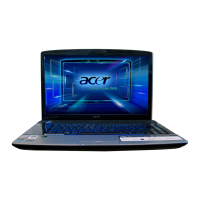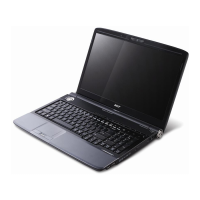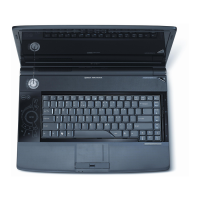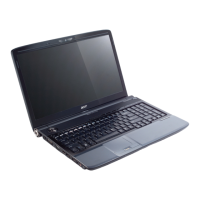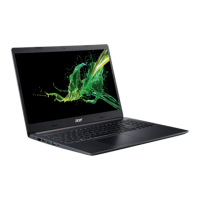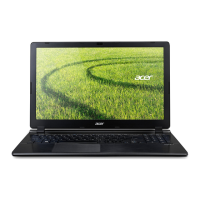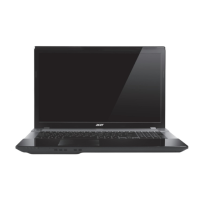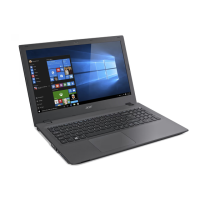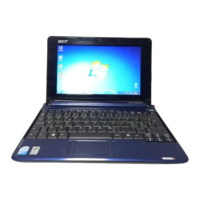What to do if Acer Aspire 6920 Laptop has power failure?
- LLindsay CuevasJul 26, 2025
If the Acer Laptop experiences a power failure where the power indicator does not turn on or stay on, refer to “Power System Check” on page 81.
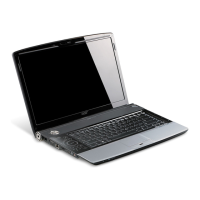
What to do if Acer Aspire 6920 Laptop has power failure?
If the Acer Laptop experiences a power failure where the power indicator does not turn on or stay on, refer to “Power System Check” on page 81.
What to do if Acer Aspire 6920 POST does not complete?
If the Acer Laptop's POST does not complete and there are no beeps or error codes, refer to “Power-On Self-Test (POST) Error Message” on page 84 and “Undetermined Problems” on page 96.
What to do if Acer Laptop POST detects an error?
If the Acer Laptop's POST detects an error and displays messages on the screen, consult the “Error Message List” on page 85.
What to do if Acer Laptop has intermittent problems?
If you are experiencing intermittent problems with your Acer Laptop that cannot be recreated, use the customer-reported symptoms and refer to “Power-On Self-Test (POST) Error Message” on page 84, “Intermittent Problems” on page 95, and “Undetermined Problems” on page 96.
| Bus type | FSB |
|---|---|
| Stepping | M0 |
| Tjunction | 105 °C |
| Processor cache | 3 MB |
| Processor cores | 2 |
| System bus rate | - GT/s |
| Processor family | Intel® Core™2 Duo |
| Processor series | Intel Core 2 Duo T8000 Series |
| Processor socket | Socket 479 |
| Processor codename | Penryn |
| Processing Die size | 107 mm² |
| Processor frequency | 2.4 GHz |
| Processor cache type | L2 |
| Processor lithography | 45 nm |
| Processor system type | Up |
| Processor manufacturer | Intel |
| Processor front side bus | 800 MHz |
| Processor operating modes | 64-bit |
| ECC supported by processor | No |
| Thermal Design Power (TDP) | 35 W |
| CPU multiplier (bus/core ratio) | 12 |
| Number of Processing Die Transistors | 410 M |
| Motherboard chipset | - |
| HDD speed | 5400 RPM |
| HDD interface | SATA |
| Total storage capacity | 320 GB |
| LED backlight | Yes |
| Display diagonal | 16 \ |
| Internal memory | 4 GB |
| Internal memory type | DDR2-SDRAM |
| Maximum internal memory | - GB |
| Memory layout (slots x size) | 2 x 2 GB |
| Type | PC |
| Graphics card family | NVIDIA |
| Compliance industry standards | IEEE 802.11a/b/g/n |
| Networking features | Gigabit Ethernet |
| Operating system installed | Windows Vista Home Premium |
| Number of battery cells | 6 |
| Charging port type | DC-in jack |
| Serial ports quantity | 0 |
| USB 2.0 ports quantity | 4 |
| Cable lock slot type | Kensington |
| Password protection type | BIOS |
| Product color | Black, Grey |
| Processor code | SLAPR |
| Processor ARK ID | 33099 |
| Processor package size | 35 x 35 mm |
| Depth | 275 mm |
|---|---|
| Width | 385 mm |
| Height | 43.6 mm |
| Weight | - g |
General safety instructions for careful reading and future reference.
Important warnings regarding product usage, electrical power, and environmental conditions.
Guidelines for safe usage of the Lithium-ion battery and its temperature limitations.
Information on operating the device in various environments, including potential interference.
Instructions for making emergency calls and proper disposal of electronic devices.
Tips for comfortable computer use, addressing eyestrain and musculoskeletal disorders.
Overview of available guides and how to access the printed User's Guide.
Instructions on basic computer care and turning the system on and off.
Guidance on caring for the computer, AC adapter, and battery pack.
Steps to launch Acer Empowering Technology and its toolbar.
Instructions for setting a password for Acer eRecovery Management.
Control enhanced sound effects and select playback devices.
Configure power management options and create custom power plans.
Utility to protect files with passwords and encryption.
Backup and restore system, applications, and drivers.
Inspect hardware specs, set BIOS passwords, and modify boot options.
Configure mobile-related system settings for convenience.
Identifies key components visible from the top of the notebook.
Details the CIR receiver and 6-in-1 card reader on the front.
Identifies ports and connectors on the left side of the notebook.
Details the optical drive, USB ports, and security lock slot.
Identifies the Tuba subwoofer and ventilation slots.
Locates memory, hard disk bays, and battery compartment.
Explains basic operation of the touchpad for cursor movement and selection.
Details Caps Lock, Num Lock, Scroll Lock, and embedded numeric keypad functions.
Explains the functions of Windows-specific keys and shortcuts.
Describes key combinations (hotkeys) for controls like brightness and volume.
Details special keys like those for the Euro and US dollar symbols.
Instructions for ejecting CD/DVD drive trays.
Information on using a Kensington-compatible security slot.
Description of the touch-sensitive entertainment interface.
Details Dolby features for surround sound and audio enhancement.
Steps to set playback devices for digital output.
Information on the 16:9 display for enhanced movie viewing.
Details the fingerprint solution for file protection and navigation.
Utility for managing multiple display settings and window layouts.
Tool to configure easy-launch buttons located above the keyboard.
Overview of battery pack features and technology standards.
Recommendations for extending the battery's lifespan and performance.
Step-by-step guide for installing and removing the battery pack.
Instructions for charging the battery and checking its level.
Tips to get the most out of battery operation and recharging efficiency.
Recommended actions when the battery-low warning appears.
Overview of controls for navigating and interacting with Acer Arcade Deluxe.
How to watch movies, including DVD and Blu-Ray playback.
Instructions for playing video clips and capturing scenes.
Accessing media on the network and configuring software preferences.
Viewing photos in albums and listening to music files.
Capturing screenshots and listening to music in the background.
Steps to safely disconnect the computer from external accessories.
Guidelines for moving the computer short distances and preparing for travel.
Considerations for traveling with the computer, including international trips.
Information on using a Kensington-compatible security slot.
Details on Supervisor, User, and Boot passwords for system security.
Overview of ports for connecting peripheral devices.
Details on Ethernet networking and Consumer Infrared (CIR) port.
Information on Universal Serial Bus (USB) and High-Definition Multimedia Interface (HDMI).
Details on ExpressCard types, insertion, and ejection.
Step-by-step instructions for installing RAM modules.
Instructions for connecting TV tuners and AV devices.
How to set the boot sequence via the BIOS utility.
Instructions to enable hard disk recovery feature in BIOS.
How to set passwords for BIOS access.
Guide to playing DVD movies, including region code information.
How to back up factory default image or drivers/applications.
Steps to create, delete, rename, or burn user backup files.
How to restore the system from factory default or user backups.
General advice for dealing with common system problems.
List of error messages and recommended corrective actions.
FCC compliance statements, operating conditions, and RF safety requirements.
Compliance notices for Canadian users and EU countries.
Notices specific to modem usage and telecommunications.
Notices for Australia and New Zealand regarding telecommunication equipment.
Laser compliance, LCD pixel statement, and Macrovision notice.
Information on radio frequency compliance and RF exposure.
